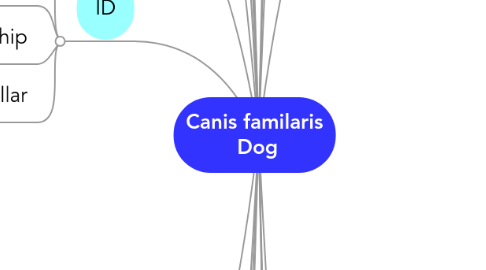
1. senses
1.1. smell
1.2. hearing
1.3. vision
1.4. touch
1.5. taste
2. evolution
2.1. domestication 50,000yrs ago
2.2. bred for different uses
3. records
3.1. health
3.1.1. medications
3.2. vacinations & worming
3.3. registration
3.4. businesses
3.4.1. consent form
3.4.2. fees estimates
3.4.3. contact details
4. behaviour
4.1. hunting
4.2. body language
4.3. vocalisations
5. breeding
5.1. gestation 63days approx
5.2. puberty, sexual maturity 5 to 24 mths
5.3. oestrus cycle
5.4. mating
5.4.1. "tie"
5.5. pregnancy diagnosis
5.6. litter size 3 \ 8 pups
5.7. weaning 2.5 to 3wks start, weaned by 6wks
6. development
6.1. Neonateal
6.1.1. transitional
6.1.1.1. socialisation
6.1.1.1.1. Juvenile
7. ID
7.1. sex
7.1.1. by external genitalia
7.2. tattoo
7.3. microchip
7.3.1. permanant but need scanner
7.4. tags / collar
7.4.1. can be lost
8. Handling and restraint
8.1. approaching
8.2. chains, leads, collars, harnessess, halti, catch pole
8.3. muzzles
8.4. lifts
8.4.1. small dog
8.4.2. large dog
8.4.3. injured
8.5. removing and placing in cages and pens
8.6. restraining
8.6.1. examination
8.6.2. for iv injection
8.7. administering medication
8.8. weighing
9. desexing
9.1. ear tattoo left ear
9.2. reduces health probs
9.3. easier to manage
9.4. no unwanted puppies
10. enrichment
10.1. toys
10.2. exercise
10.3. socialisation
10.4. obedience training
10.5. food items and bones
11. routine care
11.1. Hygine
11.1.1. Cleaning kennels, runs, pens
11.1.2. cleaning feed and water bowls
11.1.3. bedding changed, washed
11.2. food and water supplied (1 per day)
11.3. exercise
11.4. observed for abnormalities
11.5. preventative treatment / medication
11.6. grooming
11.7. play & socialisation
12. biological data
12.1. temp
12.1.1. New node
12.2. heart rate
12.3. respiration rate
12.4. life span
12.5. body weight
13. breeds
13.1. 1. Toys
13.2. 2.Terriers
13.3. 3. Gundogs
13.4. 4. Hounds
13.5. 5. Working dogs
13.6. 6. Utility
13.7. 7. Non sporting
14. digestive system
14.1. teeth
14.1.1. 2 sets, adult and baby
14.1.2. dental hygine
14.1.2.1. diet
14.1.2.2. brushing
14.1.2.3. bones, dental chews
14.1.3. incisors, canines, pre molars, molars
14.1.4. can be used to indicate age
14.2. simple
14.2.1. small caecum
14.2.2. relatively short intestines
15. Nutrition
15.1. feeding hazards to humans
15.1.1. bites
15.1.2. zoonotic diseases
15.1.3. contamination from foods
15.2. requirements
15.2.1. water
15.2.2. protien
15.2.3. vitamins
15.2.4. minerals
15.2.5. fats
15.2.6. carbohydrates
15.2.7. energy
15.3. feeding problems
15.3.1. bloat
15.3.2. fights
15.3.3. choking
15.3.4. food safety
15.3.4.1. use by date
15.3.4.2. correct storage
15.3.4.3. undamaged packaging
15.4. complete and balanced commercial diet is easiest way to ensure nutritional requirements are met.
16. Health
16.1. parasites
16.1.1. external
16.1.1.1. fleas
16.1.1.2. mites
16.1.1.3. ?ring worm
16.1.1.4. mange
16.1.2. internal
16.1.2.1. intestinal worms
16.1.2.1.1. tapeworm
16.1.2.1.2. hookworm
16.1.2.1.3. whipworm
16.1.2.1.4. roundworm
16.1.2.2. heart worm
16.2. vacination
16.2.1. parvovirus
16.2.2. hepatitis
16.2.3. distemper
16.2.4. kennel cough complex
16.3. health assessment
16.3.1. signs of distress
16.3.1.1. heart rate
16.3.1.2. respiratory rate
16.3.1.3. vocalising
16.3.1.4. hiding
16.3.1.5. reluctance to move
16.3.1.6. change in normal body temp
16.3.2. signs of disease
16.3.2.1. vomitting
16.3.2.2. diarrhoea
16.3.2.3. temp changes
16.3.2.4. behavioural changes
17. Housing
17.1. kennel design
17.1.1. materials
17.1.2. size
17.1.3. indoor / outdoor / both
